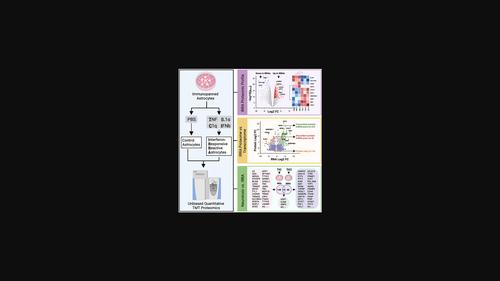Our official English website, www.x-mol.net, welcomes your feedback! (Note: you will need to create a separate account there.)
Proteomic profiling of interferon-responsive reactive astrocytes in rodent and human
Glia ( IF 6.2 ) Pub Date : 2023-11-30 , DOI: 10.1002/glia.24494 Priya Prakash 1 , Hediye Erdjument-Bromage 1, 2 , Michael R O'Dea 1 , Christy N Munson 1 , David Labib 3 , Valentina Fossati 3 , Thomas A Neubert 1, 2 , Shane A Liddelow 1, 2, 4, 5
Glia ( IF 6.2 ) Pub Date : 2023-11-30 , DOI: 10.1002/glia.24494 Priya Prakash 1 , Hediye Erdjument-Bromage 1, 2 , Michael R O'Dea 1 , Christy N Munson 1 , David Labib 3 , Valentina Fossati 3 , Thomas A Neubert 1, 2 , Shane A Liddelow 1, 2, 4, 5
Affiliation

|
Astrocytes are a heterogeneous population of central nervous system glial cells that respond to pathological insults and injury by undergoing a transformation called “reactivity.” Reactive astrocytes exhibit distinct and context-dependent cellular, molecular, and functional state changes that can either support or disturb tissue homeostasis. We recently identified a reactive astrocyte sub-state defined by interferon-responsive genes like Igtp, Ifit3, Mx1, and others, called interferon-responsive reactive astrocytes (IRRAs). To further this transcriptomic definition of IRRAs, we wanted to define the proteomic changes that occur in this reactive sub-state. We induced IRRAs in immunopanned rodent astrocytes and human iPSC-differentiated astrocytes using TNF, IL1α, C1Q, and IFNβ and characterized their proteomic profile (both cellular and secreted) using unbiased quantitative proteomics. We identified 2335 unique cellular proteins, including IFIT2/3, IFITM3, OASL1/2, MX1/2/3, and STAT1. We also report that rodent and human IRRAs secrete PAI1, a serine protease inhibitor which may influence reactive states and functions of nearby cells. Finally, we evaluated how IRRAs are distinct from neurotoxic reactive astrocytes (NRAs). While NRAs are described by expression of the complement protein C3, it was not upregulated in IRRAs. Instead, we found ~90 proteins unique to IRRAs not identified in NRAs, including OAS1A, IFIT3, and MX1. Interferon signaling in astrocytes is critical for the antiviral immune response and for regulating synaptic plasticity and glutamate transport mechanisms. How IRRAs contribute to these functions is unknown. This study provides the basis for future experiments to define the functional roles of IRRAs in the context of neurodegenerative disorders.
中文翻译:

啮齿动物和人类干扰素反应性星形胶质细胞的蛋白质组学分析
星形胶质细胞是中枢神经系统胶质细胞的异质群体,通过经历称为“反应性”的转变来对病理性侮辱和损伤做出反应。反应性星形胶质细胞表现出独特且依赖于环境的细胞、分子和功能状态变化,可以支持或扰乱组织稳态。我们最近发现了一种由干扰素反应基因(如Igtp、Ifit3、Mx1等)定义的反应性星形胶质细胞亚状态,称为干扰素反应性反应性星形胶质细胞 (IRRA) 。为了进一步推进 IRRA 的转录组定义,我们想要定义这种反应亚状态中发生的蛋白质组变化。我们使用 TNF、IL1α、C1Q 和 IFNβ 在免疫淘选的啮齿动物星形胶质细胞和人 iPSC 分化的星形胶质细胞中诱导 IRRA,并使用无偏定量蛋白质组学表征其蛋白质组谱(细胞和分泌的)。我们鉴定了 2335 种独特的细胞蛋白,包括 IFIT2/3、IFITM3、OASL1/2、MX1/2/3 和 STAT1。我们还报告说,啮齿动物和人类 IRRA 会分泌 PAI1,这是一种丝氨酸蛋白酶抑制剂,可能会影响附近细胞的反应状态和功能。最后,我们评估了 IRRA 与神经毒性反应性星形胶质细胞 (NRA) 的区别。虽然 NRA 是通过补体蛋白 C3 的表达来描述的,但它在 IRRA 中并未上调。相反,我们发现了约 90 种 IRRA 特有的蛋白质,但在 NRA 中未发现,包括 OAS1A、IFIT3 和 MX1。星形胶质细胞中的干扰素信号对于抗病毒免疫反应以及调节突触可塑性和谷氨酸转运机制至关重要。IRRA 如何发挥这些功能尚不清楚。这项研究为未来定义 IRRA 在神经退行性疾病中的功能作用的实验奠定了基础。
更新日期:2023-11-30
中文翻译:

啮齿动物和人类干扰素反应性星形胶质细胞的蛋白质组学分析
星形胶质细胞是中枢神经系统胶质细胞的异质群体,通过经历称为“反应性”的转变来对病理性侮辱和损伤做出反应。反应性星形胶质细胞表现出独特且依赖于环境的细胞、分子和功能状态变化,可以支持或扰乱组织稳态。我们最近发现了一种由干扰素反应基因(如Igtp、Ifit3、Mx1等)定义的反应性星形胶质细胞亚状态,称为干扰素反应性反应性星形胶质细胞 (IRRA) 。为了进一步推进 IRRA 的转录组定义,我们想要定义这种反应亚状态中发生的蛋白质组变化。我们使用 TNF、IL1α、C1Q 和 IFNβ 在免疫淘选的啮齿动物星形胶质细胞和人 iPSC 分化的星形胶质细胞中诱导 IRRA,并使用无偏定量蛋白质组学表征其蛋白质组谱(细胞和分泌的)。我们鉴定了 2335 种独特的细胞蛋白,包括 IFIT2/3、IFITM3、OASL1/2、MX1/2/3 和 STAT1。我们还报告说,啮齿动物和人类 IRRA 会分泌 PAI1,这是一种丝氨酸蛋白酶抑制剂,可能会影响附近细胞的反应状态和功能。最后,我们评估了 IRRA 与神经毒性反应性星形胶质细胞 (NRA) 的区别。虽然 NRA 是通过补体蛋白 C3 的表达来描述的,但它在 IRRA 中并未上调。相反,我们发现了约 90 种 IRRA 特有的蛋白质,但在 NRA 中未发现,包括 OAS1A、IFIT3 和 MX1。星形胶质细胞中的干扰素信号对于抗病毒免疫反应以及调节突触可塑性和谷氨酸转运机制至关重要。IRRA 如何发挥这些功能尚不清楚。这项研究为未来定义 IRRA 在神经退行性疾病中的功能作用的实验奠定了基础。



























 京公网安备 11010802027423号
京公网安备 11010802027423号